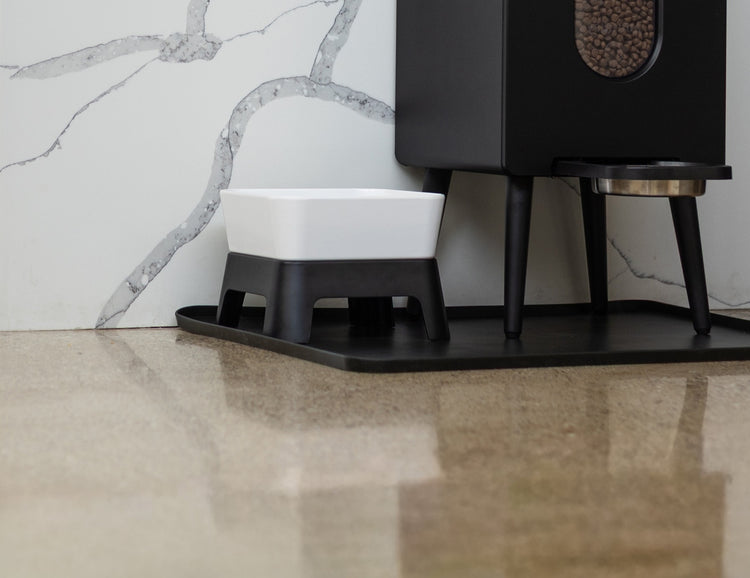How to Increase Weight in Diabetic Dogs: A Comprehensive Guide for Pet Owners
- Houndsy
Table of Contents
- Introduction
- Understanding Canine Diabetes
- Nutritional Needs for Diabetic Dogs
- Feeding Strategies to Increase Weight
- The Role of the Houndsy Kibble Dispenser
- Conclusion
- FAQs
Introduction
Did you know that the prevalence of diabetes in dogs has been steadily rising, with estimates suggesting that approximately 1 in every 300 dogs will develop diabetes at some point in their lives? As pet owners, we all want our furry companions to lead happy, healthy lives, and understanding their dietary needs is crucial, especially when they face challenges like diabetes. If you're reading this, you might be grappling with the heart-wrenching issue of helping your diabetic dog gain weight.
In this blog post, we will explore the essential strategies for increasing your diabetic dog's weight while managing their condition effectively. We will delve into the nutritional components that are vital for diabetic dogs, how to monitor their weight, and the importance of a consistent feeding schedule. By the end of this article, you'll have actionable insights to ensure your beloved dog thrives despite their diabetes, and we'll introduce you to our innovative Houndsy Kibble Dispenser as a tool to help make feeding easier and more enjoyable.
So, let’s embark on this journey together, reflecting on how we can improve our pets' quality of life through thoughtful nutrition and care.
Understanding Canine Diabetes
What is Canine Diabetes?
Canine diabetes is akin to type 1 diabetes in humans, characterized by high blood sugar levels due to a lack of insulin production. This condition can lead to increased thirst, frequent urination, and weight loss, even though the dog may have a normal or increased appetite. As pet parents, recognizing the symptoms and understanding the underlying causes of diabetes is essential for effective management.
The Importance of Weight Management in Diabetic Dogs
Weight management plays a pivotal role in managing diabetes in dogs. Overweight dogs may require higher doses of insulin, which can complicate their treatment. Conversely, underweight dogs often struggle to gain weight, leading to further health complications. Therefore, developing a tailored feeding strategy is crucial for maintaining a healthy weight and managing blood glucose levels effectively.
Nutritional Needs for Diabetic Dogs
1. Focus on Protein
For diabetic dogs, a diet rich in high-quality protein is essential. Protein helps maintain muscle mass and supports overall body function. It is important to choose protein sources that are easily digestible and non-allergenic, such as chicken, turkey, or fish. When feeding your dog, aim for a protein content that constitutes around 30% of their diet while ensuring the protein quality is high.
2. Incorporate Low Glycemic Carbohydrates
When considering carbohydrates, it is crucial to focus on low glycemic options that do not cause rapid spikes in blood sugar. Avoid high-starch foods that can lead to increased glucose levels. Instead, opt for complex carbohydrates such as sweet potatoes, brown rice, and legumes, which provide sustained energy and help stabilize blood sugar levels.
3. Increase Fiber Intake
Fiber is essential for regulating blood sugar levels as it slows down digestion and glucose absorption. A high-fiber diet can help your diabetic dog feel fuller while managing their weight. Incorporating ingredients like pumpkin, green beans, and peas can boost fiber content in their meals. However, be cautious with the amount of fiber if your dog is underweight; balance is key.
4. Healthy Fats for Energy
While managing diabetes, healthy fats play a significant role in providing energy. Include sources such as fish oil or flaxseed oil, which can also support skin and coat health. However, moderation is vital since excessive fat can lead to other health issues, especially in diabetic dogs. Aim for fats to constitute around 10-15% of their overall diet.
5. Consult with Your Veterinarian
Before making any significant changes to your dog's diet, it is always best to consult with your veterinarian. They can help tailor a meal plan that considers your dog's specific needs, preferences, and health status.
Feeding Strategies to Increase Weight
1. Regular Feeding Schedule
Consistency is crucial when feeding a diabetic dog. Establish a regular feeding schedule that aligns with your dog's insulin administration. Most dogs do well with two meals per day, spaced 12 hours apart. By feeding your dog at the same times daily, you help stabilize their blood sugar levels and improve their overall health.
2. Adjust Portion Sizes
If your dog is underweight, gradually increase their food portion sizes. Monitor their weight closely, adjusting the amount as needed. A general rule is to feed your dog 10-20% more than their usual portion if they are struggling to gain weight.
3. Use High-Calorie Foods
Select nutrient-dense foods that are high in calories but low in carbohydrates. Look for specialized diets formulated for weight gain in dogs. For instance, some dehydrated or freeze-dried raw diets can offer concentrated nutrition that is beneficial for underweight diabetic dogs.
4. Consider Snack Options
While it's essential to stick to a regular feeding schedule, offering healthy snacks can help increase your dog's caloric intake without disrupting their blood sugar levels. Healthy options include small portions of cooked chicken, turkey, or low-fat cheese. Always ensure that these snacks are low in sugar and carbohydrates.
5. Monitor and Adjust as Necessary
Keep a close eye on your diabetic dog's weight and overall health. Regular veterinary check-ups are essential for monitoring blood sugar levels and assessing weight management. If your dog is still struggling to gain weight despite following these strategies, consult your veterinarian for further guidance.
The Role of the Houndsy Kibble Dispenser
At Houndsy, we understand that feeding a diabetic dog can be a delicate balancing act. Our Houndsy Kibble Dispenser is designed with pet owners in mind, providing a convenient way to serve precise portions while eliminating the mess often associated with feeding.
Key Features of the Houndsy Kibble Dispenser:
- Convenient Crank at Standing Height: No more bending over or struggling to fill bowls. Our dispenser allows for easy access and portion control.
- Perfect Portion Control: With our dispenser, you can ensure your dog receives the exact amount of food they need without any guesswork.
- Stylish Design: Our mid-century modern design not only looks great in your home but also complements your decor while being functional.
- Large Storage Capacity: The dispenser holds 25-30 lbs of kibble, so you won’t need to refill it constantly.
- BPA-Free Liner: This ensures your dog’s food stays fresh and free from harmful chemicals.
By incorporating the Houndsy Kibble Dispenser into your routine, you can simplify the feeding process, making it easier to stick to a consistent schedule while focusing on portion control. For more details, feel free to explore our product page here.
Conclusion
Managing a diabetic dog can be challenging, especially when it comes to ensuring they maintain a healthy weight. However, with the right approach to nutrition and feeding strategies, we can help our furry friends thrive. From focusing on high-quality proteins and low glycemic carbohydrates to establishing a consistent feeding schedule, every step we take contributes to their health and well-being.
As we navigate the complexities of canine diabetes together, let's remember the importance of regular veterinary check-ups and open communication with our pet care professionals. With patience, dedication, and the right tools like the Houndsy Kibble Dispenser, we can enhance our dogs' feeding experience while managing their diabetes effectively.
Are you ready to make feeding your diabetic dog more manageable? Consider investing in the Houndsy Kibble Dispenser today and watch as feeding becomes a breeze.
FAQs
1. Can my diabetic dog eat treats?
Yes, but it’s important to choose treats that are low in sugar and high in protein. Healthy options include small portions of cooked meats or low-sodium vegetables.
2. How often should I feed my diabetic dog?
Most diabetic dogs should be fed two meals a day, approximately 12 hours apart. Consistency is key to maintaining stable blood sugar levels.
3. What should I do if my dog is losing weight?
If your diabetic dog is losing weight, consult with your veterinarian. They can help adjust your dog's diet, insulin dosage, or investigate other health issues that may be contributing to weight loss.
4. Is it safe to give my diabetic dog high-fat foods?
While healthy fats are important, moderation is essential. Too much fat can lead to complications, especially if your dog is overweight or has other health issues.
5. How can I monitor my diabetic dog's health at home?
Regularly check your dog's weight, observe their eating habits, and monitor their energy levels. Keeping a log of their food intake and any insulin administration can help you track their progress and health.
By implementing these strategies and utilizing tools like the Houndsy Kibble Dispenser, we can ensure our dogs lead healthier, happier lives while managing their diabetes effectively.













